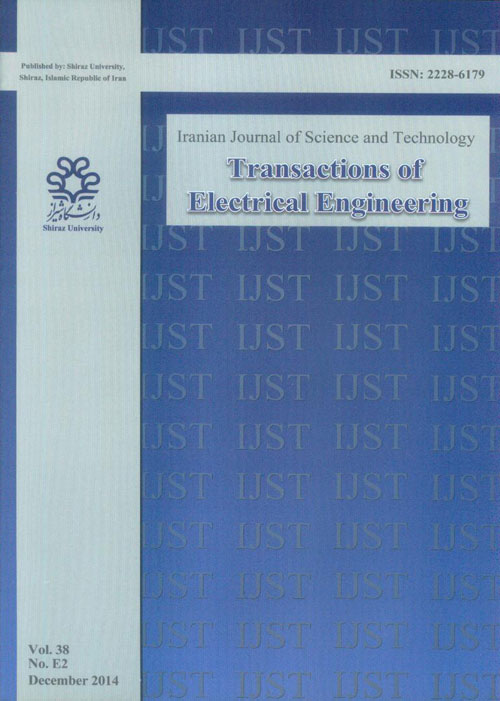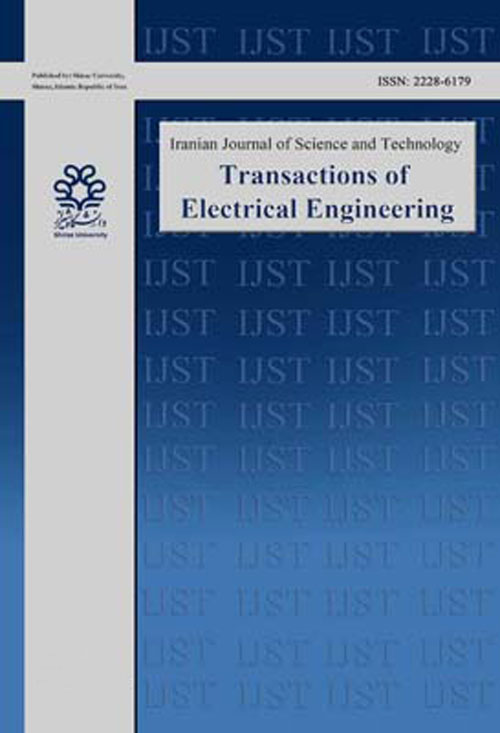فهرست مطالب

Iranian Journal of Science and Technology Transactions of Electrical Engineering
Volume:38 Issue: 2, 2014
- تاریخ انتشار: 1393/10/03
- تعداد عناوین: 7
-
-
Pages 110-122In MIMO (Multiple Input Multiple Output) radar systems multiple antennas at transmit and receive sides are used to improve the detection performance. Two important parameters which have an effect on the coverage and performance of these systems are: the transmitters’ power and the receivers’ positions. In this paper, assuming the Rayleigh scatter model for the target, the probability of detection is obtained for a MIMO radar system, by designing the Neyman-Pearson detector. Then, an iterative procedure is proposed for appropriate positioning of the receive antennas’, such that this probability of detection is improved. Finally, the transmitters’ powers are determined based on the gradient descent algorithm.Keywords: MIMO radar, Neyman, Pearson detector, antenna placement, power allocation, gradient descent
-
Pages 123-136We consider the problem of joint carrier frequency offset and channel estimation between transmitter and receiver in a frequency-selective channel MIMO-OFDM system. Recently two high performance estimators based on the expectation-maximization (EM) algorithm have been proposed. The main drawback of the maximum likelihood base algorithms, like EM algorithm, is the high computational complexity. In this paper, we propose an extended Kalman filter based estimator, which has higher performance than that of EM algorithm, while its computational complexity is lower. In addition, the Particle Swarm Optimization (PSO) algorithm is used for joint ML estimation of carrier frequency offset and channel parameters for the general model. The proposed method has a lower computational complexity than that of traditional search methods. Simulation results in comparison with Cramer-Rao bound show that the proposed algorithms outperform the EM in all ranges of signal-to-noise ratio for both channel and frequency offset estimations. Also, among them, the PSO algorithm is superior.Keywords: Carrier frequency offset (CFO), estimation, MIMO, OFDM, extended Kalman filter (EKF), particle swarm optimization (PSO)
-
Pages 137-148When channel is severely frequency selective, Orthogonal Frequency Division Multiplexing (OFDM) is a suitable candidate for high rate communications. In multipath fading channels like harsh underwater channels, due to Inter Carrier Interference (ICI) and Carrier Frequency Offset (CFO) the performance of this technique is dramatically decreased. Therefore, these effects must be alleviated to overcome the performance degradation. To do that, first the CFO’s must be estimated. In this paper, we consider an underwater channel with three sets of paths and we assume that the paths in each set have similar Doppler scale factor. For minimum transmission power, Zero Padded OFDM (ZP-OFDM) is considered. We propose a new method based on MUltiple SIgnal Classification (MUSIC) technique that facilitates the estimation of multiple CFO’s in Under Water Acoustic (UWA) channel and compare it with the derived Maximum Likelihood (ML) estimator algorithm. Simulation results show that the proposed method is robust against the received Signal to Noise Ratio (SNR) variations.Keywords: OFDM, doppler, multiple CFOs, MUSIC method, ML estimation
-
Pages 149-163Analog-to-Digital Converters (ADCs) represent a main bottleneck for realizing highspeed telecommunication systems such as cognitive radio and Software-Defined Radio (SDR) systems in addition to various requirements of transmission quality. Time-interleaved A-D converter (TI-ADC) may be considered as an effective candidate to achieve high-speed ADC with relatively slow circuits accounting for digital spectrum management. However, mismatch errors cause a considerable degradation in the performance of TI-ADC. In this paper an adaptive compensation technique is proposed for improving the overall performance in presence of offset and gain mismatches. The proposed structure behaves independent from input signal. Here, Least- Mean-Squares (LMS) algorithm has been exploited to adaptively estimate and correct mismatch errors. The Proposed correction method is structurally very simple and hence suitable for implementation on integrated circuits. Besides, proposed digital compensation algorithm is computationally efficient. Considering a four-channel TI-ADC, the proposed compensated TIADC provides an approximate improvement of 33.2dB in the performance compared to uncompensated architecture. The proposed compensated TI-ADC would be an efficient high speed ADC in most RF communication applications, and especially applications that deal with tuned frequency.Keywords: ANC. time, interleaved, mismatch errors, MIMO, wide, band communications
-
Pages 165-175In this paper, an array calibration method focusing on Direction of Arrival (DOA) on narrowband signals is presented. An array calibration procedure expresses adaptive beam forming and direction finding, which includes unknown phase and gain perturbation of the active sensor. The main purpose of this study is estimation of DOA on two or more known signal sources using Iterative Learning Control (ILC) method. Due to ILC learning ability, the amount of required calculations decreases. Furthermore, ILC method has a simple structure for working on line. As ILC is a model-free method, it requires little modeling knowledge, making it suitable for use in DOA. In this paper, a new method is proposed for finding DOA of long distance targets in sonar systems. Moreover, in the last section the simulation results approves improvement in performance of the proposed method and helps show the capabilities of the method presented.Keywords: DOA estimation, iterative learning control, active sonar, radar
-
Pages 177-189I maging synthesis methods open a new door to help scientists for further study on porous materials. H igh resolution images are required t o analyze the macroscopic propert ies of porous media. However, a few degenerated high resolution samples are available because of constraints, and low resolution measurements (such as MRI images) cannot fully describe the medium. Computer-aided approaches can help the science of porous media by generating many artificial high resolution samples using the information of available data. In this paper, a novel discriminative graphical framework is proposed which statistically models the synthesis problem.The probability distribution of high resolution image of a porous medium given a low resolution measurement is modeled by conditional random fields (CRF). A Monte Carlo approach is proposed to sample the constructed model and to generate high resolution samples. Moreover, a hierarchical CRF is proposed for gradual synthesis of high resolution porous media images. The success of the models is shown and compared through several experimental results.
-
Pages 191-203In deregulated electricity markets, strategic bidding plays an important role in a generation company’s (GENCO’s) profit maximization. A reasonable profit making bidding strategy is presented in this paper, taking into account price uncertainty as well as generator cost characteristics. Price uncertainty is considered through various statistical distributions, ensuring success in bidding process with a specified degree of confidence. The screening curve, generally used for economic evaluation of generating units in planning and operation studies, is utilized to characterize generator costs. The logically developed bidding strategy is implemented on a GENCO, that owns five different generating units. Fixed, variable and no load cost of generating units is taken into consideration to calculate GENCO profit. No load cost occurs when unit loses bid and cannot shutdown due to unit commitment constraints. Historical data of PJM electricity market is used to model price uncertainty. Finally, a comparative analysis is carried out to access the influence of accuracy of price uncertainty modeling on the GENCO profit.Keywords: Bidding Strategy, capacity factors, no load cost, price uncertainty, statistical distributions


